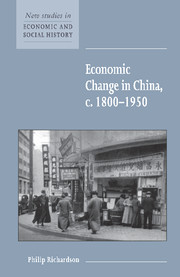Book contents
- Frontmatter
- Contents
- List of maps
- Acknowledgements
- Note on references
- Guide to pronunciation
- Dynastic chronology
- Weights and measures
- Map 1: China: provinces and cities
- Introduction
- 1 Analytical frameworks
- 2 The eighteenth-century legacy and the early nineteenth-century crisis
- 3 Growth and structural change
- 4 Foreign trade and investment
- 5 Industry: traditional and modern
- 6 Agriculture
- 7 The state and the economy
- 8 Conclusion: the legacy of the past
- Bibliography
- Index
- New Studies in Economic and Social History
- Previously published as Studies in Economic and Social History
- Economic History Society
2 - The eighteenth-century legacy and the early nineteenth-century crisis
Published online by Cambridge University Press: 05 June 2012
- Frontmatter
- Contents
- List of maps
- Acknowledgements
- Note on references
- Guide to pronunciation
- Dynastic chronology
- Weights and measures
- Map 1: China: provinces and cities
- Introduction
- 1 Analytical frameworks
- 2 The eighteenth-century legacy and the early nineteenth-century crisis
- 3 Growth and structural change
- 4 Foreign trade and investment
- 5 Industry: traditional and modern
- 6 Agriculture
- 7 The state and the economy
- 8 Conclusion: the legacy of the past
- Bibliography
- Index
- New Studies in Economic and Social History
- Previously published as Studies in Economic and Social History
- Economic History Society
Summary
It is now clear beyond any doubt that the eighteenth century was a period of considerable secular expansion for an already commercialised, or rather ‘commoditised’, economy. A private, differentiated, market economy in which commodity flows in both absolute and per capita terms may initially have been higher than for any European economy, and in which rural industry may have been more widespread, experienced a long-term upswing in which output and population rose together without any apparent decline in per capita incomes. The economic expansion was also paralleled by the maintenance of the social stability which was the overriding aim of the ruling Confucian political economy [1: 25; 15: 42; 35: 256].
It is also clear that the market expansion, however vigorous, showed few signs of generating commercial, and none of industrial, capitalism. Extensive proto-industrialisation did not lead on to the development of any of the characteristics of modern factory-based industry. And the institutions which might have been able to promote (or take advantage of) any such changes were not forthcoming [15: 145–9]. China remained locked firmly in its Smithian, agrarian, dynamics and edged closer to its Malthusian boundaries. By the end of the century economic expansion and social stability were becoming more difficult to sustain. China had begun to fall behind Europe economically and, in retrospect, she was ill prepared to meet the economic, political and military challenges of the future.
- Type
- Chapter
- Information
- Economic Change in China, c.1800–1950 , pp. 16 - 24Publisher: Cambridge University PressPrint publication year: 1999



